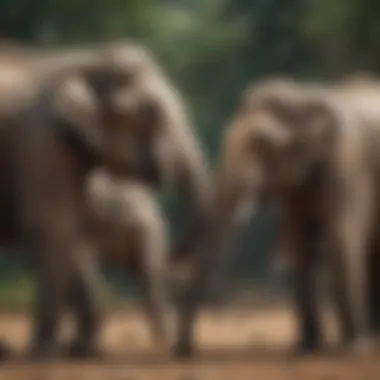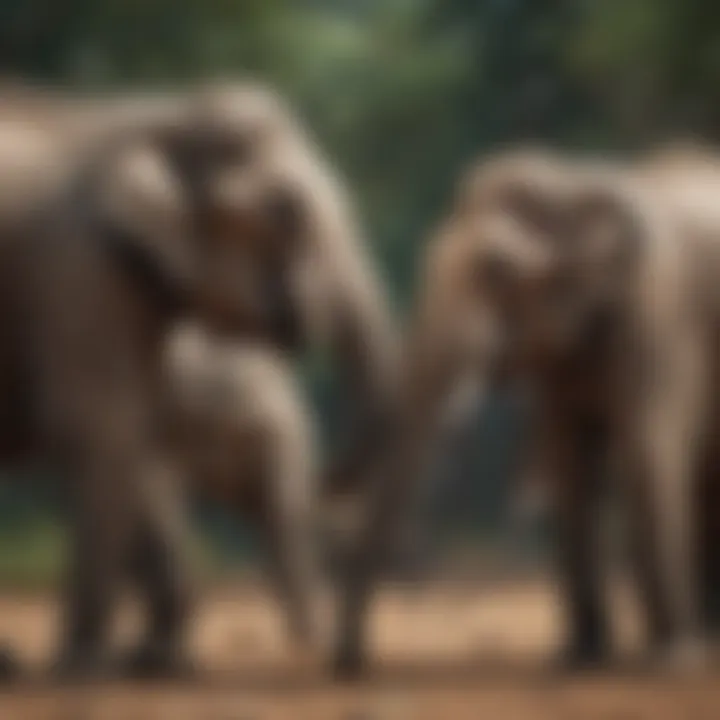Indian Elephants: Population Trends and Conservation


Intro
Indian elephants play a vital role in their ecosystems and hold cultural significance across various societies. Their populations have been a subject of concern due to various environmental and human-induced factors. An understanding of these dynamics is crucial for targeted conservation efforts. Here, we explore the complexities surrounding the status of Indian elephants, covering their population trends, conservation challenges, and the urgent need for protection.
Article Overview
Purpose of the Article
This article aims to provide a detailed analysis of the population status of Indian elephants. It seeks to inform readers about the current challenges they face and the importance of rigorous conservation actions. The goal is to compile information from various research studies, presenting a clear picture of population dynamics and threats.
Relevance to Multiple Disciplines
The status of Indian elephants intersects with various fields such as ecology, conservation biology, anthropology, and rural development. Understanding their plight informs discourse in environmental policy, wildlife management, and sustainable development strategies. Through this article, we hope to engage a diverse audience, including researchers, students, and conservation advocates, in meaningful discussions about this issue.
Research Background
Historical Context
Indian elephants (Elephas maximus indicus) have inhabited the Indian subcontinent for centuries. Once numerous, their populations have drastically decreased due to habitat loss, poaching, and human-elephant conflict. Historical records indicate that these majestic creatures once roamed across vast territories; however, modernization and agricultural expansion have led to significant fragmentation of their habitats.
Key Concepts and Definitions
To comprehend the discussions in this article, it is important to define a few key terms:
- Population Dynamics: The study of changes in the number of individuals in a population over time.
- Conservation Biology: A field dedicated to understanding biological diversity and how to protect it.
- Human-elephant Conflict: Situations that arise when the needs of growing human populations intersect with habitat occupied by elephants, often leading to negative outcomes for both parties.
By tackling these topics, this article aims to draw attention to the significant, yet overlooked, challenges faced by Indian elephants in their struggle for survival today.
Overview of Indian Elephants
Understanding the Indian elephant is crucial for comprehending the broader ecological and cultural narratives in India and beyond. Despite their iconic status, these elephants face significant challenges. This section lays the groundwork for the subsequent discussions by defining the species and exploring its historical context.
Defining the Indian Elephant
The Indian elephant, scientifically known as Elephas maximus indicus, is one of the three recognized subspecies of the Asian elephant. They are characterized by their smaller size compared to African elephants, with males averaging between 4 to 5.5 meters in length and weighing around 2,200 to 5,000 kilograms. Their smaller ears and distinctively arched back distinguish them from their African counterparts. Indian elephants also possess a unique social structure, typically found in matriarchal family groups led by older females. This complex social behavior plays a substantial role in their survival, as it facilitates the sharing of knowledge regarding foraging, migration routes, and alertness to predators.
Historical Context
Historically, Indian elephants have held immense cultural significance in regions across Asia. They have been used in warfare, logging, and religious ceremonies. Ancient texts depict elephants as symbols of wisdom and strength. Moreover, archaeological findings suggest that the relationship between humans and elephants dates back thousands of years. However, as civilizations expanded, habitat loss and exploitation began to take a toll on their populations. By the late 19th century, extensive hunting and the encroachment of agriculture severely reduced their numbers. Today, they inhabit only 60% of their historic range, a reality that underscores the importance of conservation measures. The plight of the Indian elephant is not merely an ecological concern, but also a reflection of the interconnectedness between humans and wildlife.
"The Indian elephant is not just a species; it represents an intricate part of India’s cultural heritage and ecological balance."
"The Indian elephant is not just a species; it represents an intricate part of India’s cultural heritage and ecological balance."
The remainder of the article will delve into current population estimates, geographic distribution, and conservation efforts, ultimately emphasizing the urgency of affirming protective measures for these majestic creatures.
Current Population Estimates
Understanding the population estimates of Indian elephants is crucial for several reasons. These figures are not just numbers; they represent the survival of a species that plays an integral part in its ecosystem. Accurate estimates can help identify population strengths and weaknesses, guiding conservation efforts effectively. Moreover, such data reflects the impacts of external factors like habitat loss, poaching, and climate changes on elephant numbers.
Global Population Estimates
Recent studies have indicated that the global population of Indian elephants is approximately 27,000 to 30,000 individuals. This range may vary slightly depending on numerous research efforts and field surveys conducted in various states across India. The Indian elephant, being a subspecies of the Asian elephant, has a more limited distribution and population than its African counterpart, making precise estimates even more significant.
The majority of Indian elephants inhabit various protected areas and national parks such as Corbett National Park, Periyar Wildlife Sanctuary, and Kaziranga National Park. However, the numbers are not uniform throughout the country. Some regions, like southern India, exhibit higher densities of elephants, while other areas are experiencing significant declines.
"Population estimates are not simply statistics; they hold the key to ensuring the future of Indian elephants."


"Population estimates are not simply statistics; they hold the key to ensuring the future of Indian elephants."
Monitoring these populations helps authorities implement necessary actions for conservation and establish wildlife corridors to connect fragmented habitats.
Population Trends Over the Decades
When one observes population trends in Indian elephants over the last few decades, a sobering reality emerges. Despite efforts aimed at conservation, the population numbers have shown fluctuating trends influenced by various human activities and environmental conditions.
In the early 20th century, the population was markedly higher, but deforestation, urbanization, and agricultural expansion dramatically reduced their numbers. In recent years, conservation strategies have seen some success, leading to slight increases in certain areas. However, the overall demographic trend remains concerning due to ongoing threats.
Noteworthy points from these trends include:
- Post-Independence Trends (1947-1990): Numbers declined critically due to habitat destruction and increased poaching activities.
- 1990s to Early 2000s: Some recovery was noted due to enhanced conservation initiatives and the establishment of protected areas.
- Recent Years: Current estimates indicate stability in some ecosystems, but these gains are precarious.
Assessing these trends is vital for understanding the efficacy of past and ongoing conservation efforts and can guide future priorities in the struggle to maintain viable elephant populations.
Geographic Distribution
Understanding the geographic distribution of Indian elephants is essential for several reasons. It provides insights into their ecological needs, habitat preferences, and the areas that require focused conservation efforts. The distribution patterns highlight regions where elephants can thrive and assist in identifying critical habitats that must be preserved. Population management strategies can be effectively developed based on this information.
Natural Habitat and Range
Indian elephants primarily inhabit forests, grasslands, and shrublands of South and Southeast Asia. Their range extends across several Indian states, including Assam, Karnataka, and Uttar Pradesh. Typically, these elephants favor moist deciduous forests, but they adapt well to different ecosystems ranging from tropical rainforests to dry scrublands.
The presence of water sources is a crucial factor in their habitat selection. Elephants need to drink frequently and depend on water bodies for cooling during hot seasons. The landscape they occupy enables them to migrate in search of food and water, which is essential for their survival.
Moreover, land use changes, such as agriculture and urbanization, threaten their natural habits. Habitat fragmentation has become a significant concern as it not only reduces living area size but also impacts migratory routes and social structures within elephant populations.
Concentration Areas in India
In India, certain areas have been identified as concentration zones for elephant populations. These include:
- Kaziranga National Park: Located in Assam, this park is renowned for its rich biodiversity. It serves as a vital habitat for a significant population of Indian elephants.
- Bandipur National Park: Situated in Karnataka, this sanctuary is part of the Nilgiri Biosphere Reserve, offering a protected area where elephants can roam freely.
- Periyar National Park: Also in Kerala, it provides essential forest and lake ecosystems supportive of elephant life.
These concentration areas are strategic for conservation because they harbor large territories that support stable populations. Preservation of these locations is key to maintaining genetic diversity and ensuring the long-term survival of the species in the wild. Careful monitoring and protection of these habitats not only benefits elephants but also contributes to the conservation of countless other species sharing the same ecosystem.
"The preservation of key habitats is not just vital for the elephants themselves but also for the ecological balance that sustains various forms of wildlife."
"The preservation of key habitats is not just vital for the elephants themselves but also for the ecological balance that sustains various forms of wildlife."
Conservation Status
The conservation status of Indian elephants is crucial to understanding the broader implications for biodiversity and ecosystem health. As a keystone species, these elephants play a significant role in maintaining the structure of their environment. Their habitat use influences other wildlife and plant communities, thereby sustaining the ecological balance. Conserving Indian elephants is not just about protecting one species; it is about ensuring the integrity of entire ecosystems. This makes the examination of their conservation status a vital aspect of this article.
In India, the challenges faced by Indian elephants are numerous and complex. Factors such as habitat loss, poaching, and human-elephant conflict have devastating effects on their populations. Monitoring their status provides insights into these threats and informs conservation strategies. Understanding their conservation status also helps to engage policymakers, researchers, and the public in meaningful actions against the biodiversity crisis.
Effective conservation measures depend heavily on accurate data and research. Consequently, analyzing the international classification systems and legal frameworks in place helps to illuminate the benefits and gaps in current protections. This section will explore these important elements in depth.
International Union for Conservation of Nature (IUCN) Classification
The International Union for Conservation of Nature (IUCN) classifies species based on their extinction risk. Indian elephants are currently listed as "Endangered" on the IUCN Red List. This classification reflects several factors: population decline, restricted geographical range, and the ongoing threats from human activity. Understanding this classification is crucial for strategizing effective conservation efforts.
The IUCN’s classification system prompts international attention and resources toward the species listed as endangered. Conservationists and governments can use this classification to prioritize funding and develop targeted plans to mitigate the risks that threaten Indian elephants. This classification also highlights the necessity for collaborative conservation actions across borders, as the issue is not isolated to India alone.
Furthermore, this classification is not static. Continuous updates based on ongoing research allow for adaptive management in conservation efforts. For instance, shifts in habitat quality or population dynamics can lead to re-evaluation of their status. Promoting awareness about their endangered status can also mobilize public support for conservation initiatives.
Legal Protections in India


In India, various legal frameworks protect Indian elephants and their habitats. The Wildlife Protection Act of 1972 is a pivotal legislation that prohibits the hunting and trade of elephants and their parts. It designates elephants as protected animals under this law, which is crucial given the threat of poaching.
Additionally, the Project Elephant scheme was launched in 1992, focusing on conserving elephant habitats and corridors. This initiative aims to address the human-elephant conflict in sensitive areas while ensuring that the elephants can migrate freely without disruption. Understanding these legal protections is essential as they provide the foundation for broader conservation strategies.
However, the effectiveness of these laws is often challenged by enforcement issues. Corruption, lack of resources, and insufficient training for wildlife protection staff can hinder the application of these laws. Enhancing local communities' involvement in conservation efforts can be a significant factor in overcoming these challenges. When communities feel ownership and direct benefits from conservation, compliance increases, ensuring better protection.
"Legal frameworks alone cannot save the Indian elephants. An integrated approach that combines legislation with community involvement is key to success."
"Legal frameworks alone cannot save the Indian elephants. An integrated approach that combines legislation with community involvement is key to success."
Major Threats to Indian Elephants
The threats faced by Indian elephants are multifaceted and deeply interconnected with socio-economic and environmental factors. Understanding these threats is crucial for developing effective conservation strategies. Each of these threats contributes to the decline of elephant populations and their habitats, making it essential to prioritize their mitigation. Without addressing these issues, conservation efforts may fall short of making a significant impact.
Habitat Loss and Fragmentation
One of the most pressing threats to Indian elephants is habitat loss and fragmentation. As urban areas expand and agricultural activities increase, the natural habitat of elephants is being degraded and reduced. This loss not only limits the space available for them to roam but also restricts access to food and water sources. Elephants need vast territories to thrive, as their foraging behavior, migration patterns, and social structures depend on large, contiguous habitats.
Fragmentation occurs when these habitats are broken up into smaller patches due to roads, railways, and human settlements. Fragmented landscapes can make it difficult for elephants to find mates and disperse among populations. This, in turn, affects genetic diversity and long-term population stability. Strategies to combat habitat loss include establishing wildlife corridors and protecting areas of critical habitat.
Poaching and Illegal Trade
Poaching is a significant and ongoing threat to Indian elephants. While the primary target often includes their ivory and skin, elephants are also hunted for their meat and other body parts. The illegal wildlife trade has elevated the risk of poaching in areas where enforcement of conservation laws is lax. The high demand for ivory in markets, particularly in parts of Asia, fuels this crisis.
Governments and organizations need to strengthen laws and enforcement to combat poaching. Public awareness campaigns are also vital in changing consumer behavior toward ivory products. Collaboration with international organizations can enhance the effectiveness of anti-poaching measures, through intelligence sharing and resource allocation.
Human-Wildlife Conflict
Human-wildlife conflict presents another serious challenge for Indian elephants. As human populations grow and agricultural activities expand, encounters between elephants and humans have increased. This often results in elephants raiding crops, leading farmers to retaliate, which can involve harming or killing elephants. The conflict created by competition for resources can lead to severe consequences for both sides.
Community engagement is critical in addressing these conflicts. Solutions may include employing non-lethal deterrents, creating buffer zones, and securing compensation for farmers affected by elephant damage. Education programs that promote coexistence strategies can also help reduce tensions between elephants and local communities.
"Addressing habitat loss, poaching, and human-wildlife conflict is essential for the long-term survival of Indian elephants."
"Addressing habitat loss, poaching, and human-wildlife conflict is essential for the long-term survival of Indian elephants."
Conservation Efforts
Conservation efforts are essential for the survival of Indian elephants, which face numerous threats from habitat loss, poaching, and human-wildlife conflict. These initiatives aim to protect not only the elephants themselves but also their ecosystems. By doing so, they help maintain biodiversity and ensure that future generations can appreciate these majestic creatures.
Government Initiatives
The Indian government has implemented various policies and programs to safeguard elephant populations. One significant effort is the establishment of protected areas and wildlife sanctuaries, which serve as safe havens for elephants and other wildlife. Notable reserves include the Bandipur National Park and Periyiar Tiger Reserve.
The government has also created the Project Elephant scheme, aimed specifically at protecting elephant habitats and corridors. This project provides funds for anti-poaching measures and habitat restoration. Additionally, the Ministry of Environment, Forest and Climate Change collaborates with state governments to enhance these conservation strategies. A portion of the efforts also focuses on raising public awareness about the importance of conserving these animals and their habitats.
Non-governmental Organizations (NGOs) Contributions
Various non-governmental organizations play a pivotal role in elephant conservation efforts. Organizations such as the World Wildlife Fund (WWF) and the Wildlife Trust of India actively promote awareness and help develop programs that focus on elephant protection. They work on strategies that mitigate human-elephant conflict, especially in areas where communities and elephants share land.
NGOs also conduct research to study population dynamics and health issues affecting Indian elephants. They often partner with local communities to implement conservation projects that are effective and culturally sensitive. These collaborations not only aid in protecting elephants but also boost local economies through ecotourism.
Community Involvement in Conservation
Community involvement is vital for the success of any conservation endeavor. Local populations are often the first line of defense against threats to wildlife. By educating and engaging local communities, conservationists can create a sense of stewardship towards the elephants and their habitats.
Programs that educate villagers about the ecological importance of elephants can foster a cooperative atmosphere. For instance, training programs that highlight sustainable practices and offer alternative livelihoods can reduce reliance on activities that harm elephants, such as illegal logging or poaching.


Furthermore, community-led initiatives often include monitoring wildlife corridors to prevent human-elephant conflict. Such efforts empower local residents and encourage them to take an active role in conservation.
Involving the community in conservation helps establish a shared responsibility for protecting wildlife, ensuring the success of conservation interventions.
Involving the community in conservation helps establish a shared responsibility for protecting wildlife, ensuring the success of conservation interventions.
The combination of government action, NGO projects, and community engagement creates a robust framework for conserving Indian elephants, ultimately leading to a healthier ecosystem and a sustainable coexistence between humans and wildlife.
Role of Indian Elephants in the Ecosystem
The role of Indian elephants extends far beyond their impressive size and grandeur. Their contributions shape the ecological landscape significantly. These elephants are considered keystone species, meaning their presence and behavior play a critical role in maintaining the biodiversity and health of their ecosystems. Understanding their impact is essential for conservation efforts and for appreciating the intricate balance of life within their habitats.
Keystone Species Concept
As a keystone species, Indian elephants exert a profound influence on their environment. Their activities create and alter habitats that other species depend on. For instance, elephants are known to engage in tree uprooting, which can lead to the creation of clearings in dense forests. This behavior not only helps in the regeneration of different plant species but also provides habitation and foraging ground for a variety of smaller wildlife. Here are some specific ways Indian elephants function as keystone species:
- Seed Dispersal: Elephants eat a variety of fruits and plants, playing a key role in seed dispersal. Many plant species rely on elephants to spread their seeds over large distances, facilitating plant diversity.
- Grazing Impact: Their browsing habits can influence the structure of vegetation. By controlling tree density and promoting grass growth, they help sustain a mosaic of habitats that support diverse animal populations.
- Waterhole Creation: By digging in dry riverbeds and creating waterholes, elephants provide vital water sources for many animals during dry seasons. These waterholes can also attract numerous species, enhancing biodiversity.
**"In ecosystems where elephants roam, their activities bolster the resilience and diversity of other species, making them indispensable."
**"In ecosystems where elephants roam, their activities bolster the resilience and diversity of other species, making them indispensable."
The decline in elephant populations can lead to cascading effects across ecosystems. Loss of their foraging and browsing can lead to overgrowth of certain plant species, disrupting the balance and potentially leading to habitat degradation. Given their profound ecological role, conservation of Indian elephants is more than just preserving a single species; it is about maintaining the integrity of the entire ecosystem.
Ultimately, protecting Indian elephants means safeguarding the health of their environments. As they navigate their habitats, the benefits they bring ripple through the ecological web, impacting countless other species and the overall health of the ecosystems they inhabit. As we consider future conservation strategies, acknowledging their role as keystone species is essential for fostering robust, resilient ecosystems.
Future of Indian Elephants
The future of Indian elephants holds tremendous significance, both for the species and for the ecological balance they help maintain. As keystone species, their presence ensures the health of their habitats and the species that coexist within them. The challenges faced today, such as habitat loss, poaching, and climate change, make it imperative to address the potential changes in population dynamics. Understanding these elements assists in formulating targeted conservation strategies that aim to curb declines and improve the resilience of elephant populations.
Projected Population Changes
Current studies suggest that if conservation efforts falter, Indian elephant populations may continue on a downward trajectory. Researchers predict a decline in numbers under scenarios lacking effective intervention. A combination of habitat fragmentation and human encroachment exacerbates this decline, interrupting migration routes and limiting genetic diversity.
Conversely, if proactive measures are taken, population stability could be achieved. The implementation of wildlife corridors and better management of protected areas may contribute positively to population numbers. While predictions vary, estimates illustrate that maintaining existing conservations efforts could lead to incremental increase in populations over the coming decades.
"The fate of Indian elephants reflects our commitment to shared ecosystems. Their survival hinges on informed decisions today."
"The fate of Indian elephants reflects our commitment to shared ecosystems. Their survival hinges on informed decisions today."
Importance of Continued Research
Continued research is pivotal to understanding Indian elephant dynamics comprehensively. Ongoing studies provide crucial data on behaviors, habitat preferences, and social structures. Knowledge derived from these studies informs conservation strategies allowing them to be adaptive and informed.
Moreover, scientific findings help predict potential issues stemming from climate changes and legal protections. The inclusion of local community insights enriches the research, ensuring it remains relevant and effective. Collaborative efforts between researchers, governments, and NGOs form a robust network that enhances the quantity and quality of information available for decision-making.
Epilogue
The conclusion serves as the capstone of this detailed examination into the status of Indian elephants. It synthesizes the various elements discussed, reinforcing the necessity of awareness, urgency, and action regarding this majestic species.
Summary of Key Insights
The key points concerning Indian elephants highlight their ecological significance, the mounting challenges they face, and the collaborative efforts required to ensure their survival.
- Conservation Importance: Indian elephants maintain the health of their ecosystems. They assist in seed dispersal and help shape their habitat, enhancing biodiversity.
- Population Decline: Despite historical significance, there is a concerning decline in their numbers, largely influenced by habitat loss and poaching.
- Current Conservation Efforts: Successful initiatives by both government and NGOs are in place, but they require scaling up and continuous support.
- Need for Research: Ongoing scientific inquiry into population trends and behavior is critical to addressing conservation challenges effectively.
"The plight of Indian elephants is a reflection of the broader environmental challenges faced globally; their conservation is not just about saving a species, but about maintaining ecological balance and heritage."
"The plight of Indian elephants is a reflection of the broader environmental challenges faced globally; their conservation is not just about saving a species, but about maintaining ecological balance and heritage."
Call to Action for Conservation Efforts
The imperative for concerted conservation actions cannot be overstated. Individuals, communities, and governments must join forces to present a united front against the threats faced by Indian elephants.
- Education and Awareness: Promoting education on the significance of elephants within ecosystems can mobilize community support for conservation initiatives.
- Support Local Initiatives: Engaging with local NGOs and conservation programs is vital. Contributing time, resources, or funds will enhance their sustainability.
- Legislative Actions: Advocating for stronger legal protections can deter poaching and habitat destruction.
- Global Partnerships: Collaboration between various stakeholders, including international organizations, can facilitate resource sharing and strategy development.



